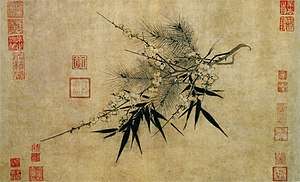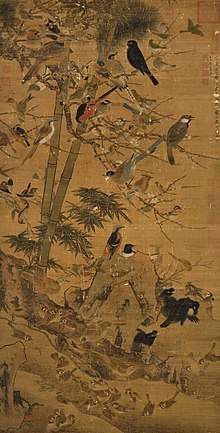Three Friends of Winter
The Three Friends of Winter is an art motif that comprises the pine, bamboo, and plum.[1] The Chinese celebrated the pine, bamboo and plum together, as they observed that these plants do not wither as the cold days deepen into the winter season unlike many other plants.[2] Known by the Chinese as the Three Friends of Winter, they later entered the conventions of East Asian culture.[3][4] Together they symbolize steadfastness, perseverance, and resilience.[5] They are highly regarded in Confucianism and as such represent the scholar-gentleman's ideal.[1][6]
| Three Friends of Winter | |||||||
|---|---|---|---|---|---|---|---|
 The Three Friends of Winter by the painter Zhao Mengjian, Song dynasty | |||||||
| Chinese name | |||||||
| Traditional Chinese | 歲寒三友 | ||||||
| Simplified Chinese | 岁寒三友 | ||||||
| |||||||
| Vietnamese name | |||||||
| Vietnamese | Tuế hàn tam hữu | ||||||
| Korean name | |||||||
| Hangul | 세한삼우 | ||||||
| Hanja | 歲寒三友 | ||||||
| |||||||
| Japanese name | |||||||
| Kanji | 歳寒三友 | ||||||
| Hiragana | さいかんさんゆう | ||||||
| |||||||
History
The Three Friends of Winter are common in works of art from Chinese culture[7] and those cultures influenced by it. The three are first recorded as appearing together in a ninth-century poem by the poet Zhu Qingyu (朱慶餘) of the Tang dynasty.[6] The Southern Song dynasty artist Zhao Mengjian (趙孟堅, c. 1199–1264), among others of the time, made this grouping popular in painting.[6]
The actual term "Three Friends of Winter" can be traced back to the earliest known mention in literature, the Record of the Five-cloud Plum Cottage (五雲梅舍記) from The Clear Mountain Collection (霽山集) by the Song dynasty writer Lin Jingxi (林景熙, 1242–1310):[2][8]
For his residence, earth was piled to form a hill and a hundred plum trees, which along with lofty pines and tall bamboo comprise the friends of winter, were planted.[2]
即其居累土為山,種梅百本,與喬松,脩篁為歲寒友。[8]
Cultural symbolism

Culturally, the Three Friends of Winter—pine, bamboo, and plum—are grouped together in the context of winter because they all flourish at that season.[1] For this reason they are commonly known as the Three Friends of Winter.[1] They are also referred to simply by their linked names: Song Zhu Mei (松竹梅) in Chinese, transliterated as Sho Chiku Bai in Japanese (literally "pine, bamboo, plum")[9] or Song Jug Mae (송죽매) in Korean.
In a Korean poem by Kim Yuki (1580–1658), the three friends are brought together in order to underline the paradoxical contrast:
Peach and plum of springtime, don't flaunt your pretty blossoms;
Consider rather the old pine and green bamboo at year's end.
What can change these noble stems and their flourishing evergreen?[10]
In Japan, they are particularly associated with the start of the New Year, appearing on greeting cards and as a design stamped into seasonal sweets.[11] Shōchikubai (松竹梅) is sometimes also used as a three-tier ranking system. In this context, the pine (matsu, 松) usually is the highest rank, followed by bamboo (take, 竹) as the middle rank, and plum (ume, 梅) as the lowest. [12]
In Vietnam, the three along with chrysanthemum create a combination of four trees and flowers usually seen in pictures and decorative items. The four also appear in works but mostly separately with the same symbolic significance.[13]
See also
- Four Gentlemen of the Year
- Four Treasures of the Study
- Trees in Chinese mythology
References
- "Chinese symbols" (PDF). British Museum. p. 1. Retrieved 11 August 2011. Archived 5 December 2009 at the Wayback Machine.
- "The Three Friends of Winter: Paintings of Pine, Plum, and Bamboo from the Museum Collection". National Palace Museum. January 2003. Retrieved 10 August 2011. Archived 12 February 2003 at the Wayback Machine.
- "Three Friends of Winter". Colby College. Retrieved 10 August 2011.
- "Cultivating Virtue: Botanical Motifs and Symbols in East Asian Art". Harvard Art Museums. Retrieved 11 August 2011.
- Dusenbury, Mary (2004). Flowers, dragons and pine trees: Asian textiles in the Spencer Museum of Art. New York: Hudson Hills Press. p. 248. ISBN 978-1-55595-238-9.
- Welch, Patricia Bjaaland (2008). Chinese art: A guide to motifs and visual imagery. North Clarendon: Tuttle Publishing. p. 37. ISBN 978-0-8048-3864-1.
- Welch, Patricia Bjaaland (2008). Chinese art: a guide to motifs and visual imagery. North Clarendon: Tuttle Publishing. pp. 20–21. ISBN 978-0-8048-3864-1.
- "歲寒三友". National Palace Museum. Retrieved 13 August 2011. Archived 26 January 2003 at the Wayback Machine.
- Qiu, Peipei (2005). Basho and the Dao: The Zhuangzi and the transformation of Haikai. Honolulu: University of Hawaii Press. p. 214. ISBN 978-0-8248-2845-5.
- The Bamboo Grove, ed. and trans. Richard Rutt, University of California Press 1971, poem 18
- Bamboo in Japan Nancy Moore Bess and Bibi Wein, Kodansha International 2001, p.170
- "松竹梅 at jisho.org".
- Văn hóa dân gian. Viện văn hóa dân gian, ̉Uy ban khoa học xã hội Việt Nam. 2005. p. 30.